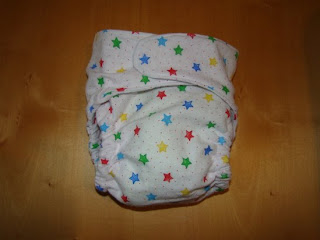
For this nappy wrap (cover) I am using the Rita's Rump Cover pattern (http://handmadebyrita.blogspot.com/2007/10/httpwww.html).
To make this cover you will need -
Fleece fabric - about half a yard, or two different quarter-yards.
Some elastic.
Polyester thread. Do not use cotton thread as it will wick any moisture through to the outside of the wrap!
A sewing machine - preferably with a straight stitch and a 3-step zigzag stitch but any sewing machine will do!
Velcro/Aplix.
Poly/cotton piping.
1 - Draw around the cover pattern on the wrong side of your inner fabric (mine is a plain microfleece), then cut out, adding an extra half inch all the way around. The cutting doesn't have to be perfect as you are going to sew along the drawn line. Make sure you mark your elastic start and end points on your pattern, in the seam allowance.

2 - Place your inner piece right-sides-together with your outer fabric and cut out.


3 - Make your tabs. You can either simply cut two pieces of hook tape, each about 1.5 - 2" long and cut the edges into a curve, or make the more complicated but softer tabs as follows...
Take your Aplix and cut two pieces of hook and two pieces of loop, each about 1.5 - 2" long. Keep them stuck together for now. Cut the edges into curves at one end, so they look like this:
Take a piece of poly/cotton piping.
Open up your Aplix. Place the pieces back to back (one hook piece and one loop piece), catching the piping between the layers to make an edging.


Stitch around the edge of your Aplix, ensuring you catch both layers of Aplix and the piping. I sew around the Aplix once with a straight stitch ...


... then I turn around and sew back around the edge from the other direction, using a zigzag stitch and making sure half of the stitch is on the Aplix and the other half is on the piping.


4 - Now to elasticate one of the leg holes. Take your elastic. I usually use clear elastic for nappies, but braided elastic works really well with this pattern. Here I have some ordinary quarter-inch elastic from the local sewing shop. Do not cut the elastic yet! Put the elastic on your nappy inner fabric, on the outside of the drawn line - actually in the seam allowance. Make sure about an inch of elastic is before the elastic start mark that you drew in step 1. Put your sewing machine on the 3-step-zigzag stitch (or normal zigzag if you don't have a 3-step). Starting at the elastic start mark, stitch in reverse for an inch, then forwards for an inch, without stretching the elastic or fabric. This anchors your elastic in place.
5 - Make sure your needle is down in the fabric before you do the next bit! Pull your elastic hard and keep it stretched as hard as you can while you sew along it, keeping the elastic just outside the drawn line on your fabric. Do not stretch or pull the fabric as you do this.
When you reach the elastic finish mark at the other end of the nappy, stop. Don't stretch the elastic. Sew one more inch, then sew backwards for one inch, to anchor this end of the elastic well. Cut off the excess elastic.
6 - Repeat steps 4 and 5 for the other leg elastic and the back elastic. Your nappy inner should now look roughly like this.
7 - Place the tabs on the nappy wings on the right side of the outer fabric, with the loop side facing downwards. Pin your inner layer on top of your outer layer, right sides together, stretching the elastic as you pin, so they fit together.

8 - Remember during this next part that we are going to leave a large gap at the front edge of the nappy, to enable us to turn the whole thing the right way out! Change to a straight stitch on your sewing machine. Stitch along the drawn line on your inner fabric, stretching the elastic as you go past it, and making sure that you do NOT catch any of the elastic in your stitching. I sew slightly inside the drawn line as I go past the elastic.

Remember to leave that gap!!
Your nappy wrap should now look something like this.
9 - Trim the seams around the corners and past the elastic, fairly close to the stitching. Do not trim along the bottom (the front of the wrap) or you'll make it very difficult to stitch together.
10 - Turn your wrap the right way round by pushing it through the open gap. Make sure you push all the curves out neatly. Your wrap should now look like this
11 - Nearly finished!! You need to close the gap. Fold the edges inside and pin them together neatly. Starting to one side of the gap, stitch all around the edge of the wrap. For most of the wrap you stitch very close to the edge.
When you get to the elastic, do not stitch close to the edge. Move inwards, stretch the elastic and sew along the wrap just inwards from where the elastic is. This creates a nice little channel for the elastic and gives a lovely neat finish to the leg edges.
























































